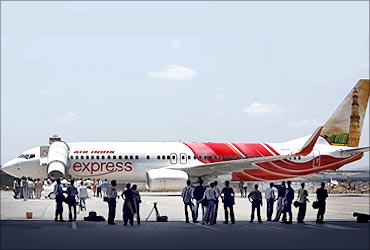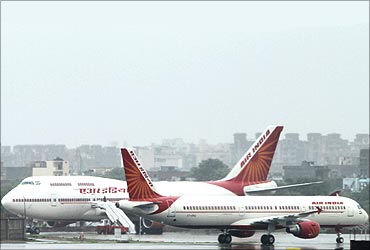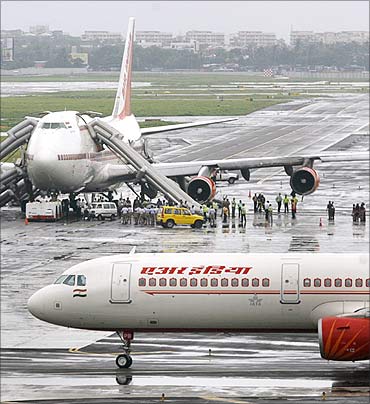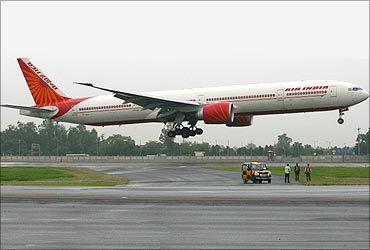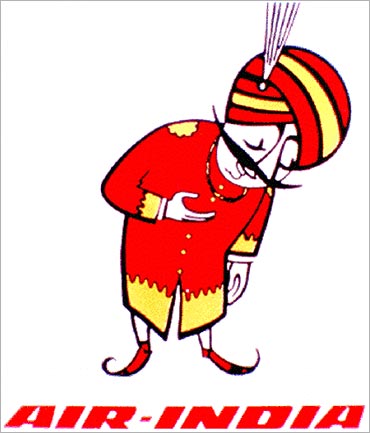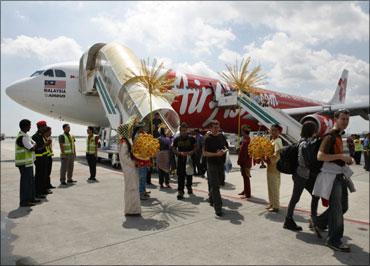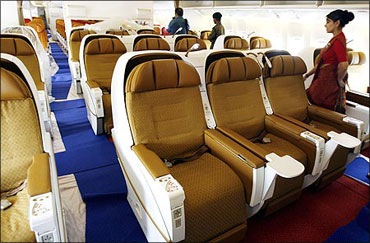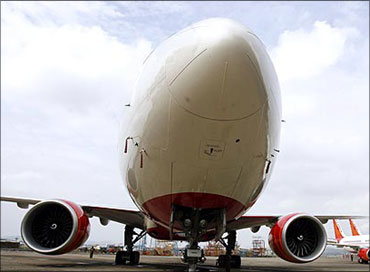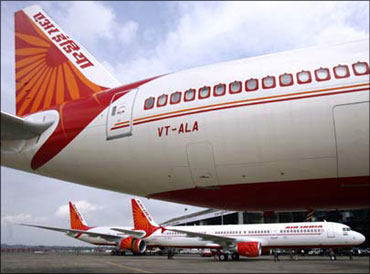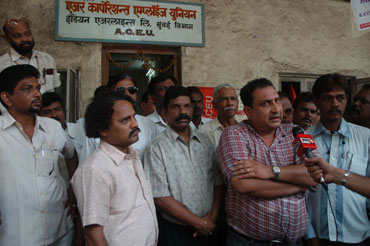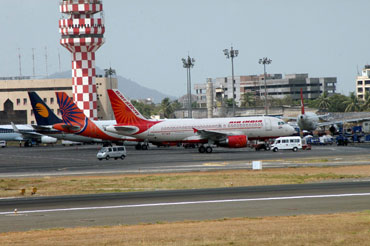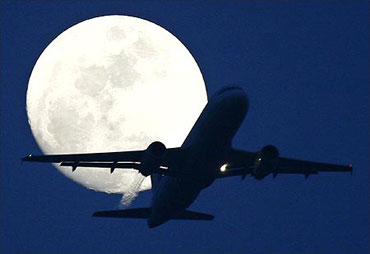 | « Back to article | Print this article |
Can Air India overcome the crisis?
In the 18 months that Arvind Jadhav has been the chairman of state-owned Air India, he has faced more than one crisis.
Recently, the independent directors on the company's board demanded the removal of Pawan Arora, the boss of Air India Express, the low-cost arm of the airline, for misrepresenting facts.
The directive was opposed by Chief Operating Officer Gustav Baldauf who told Jadhav the procedure was not followed and Arora wasn't given a chance to defend the allegations against him.
Click NEXT to read on...
Can Air India overcome the crisis?
In this chaos, the only redeeming piece of information to reach Jadhav's desk was that the airline has pruned its losses.
The operating loss decreased 39 per cent from Rs 5,672 crore (Rs 56.72 billion) in 2008-09 to Rs 3,472 crore (Rs 34.72 billion) in 2009-10, and the net loss fell 23 per cent from Rs 7,189 crore (Rs 71.89 billion) to Rs 5,551 crore (Rs 55.51 billion).
Click NEXT to read on...
Can Air India overcome the crisis?
So does Jadhav have a turnaround plan for Air India which will get the financially-crippled airline back in the black?
Will he be able to prove some of his bosses in the aviation ministry wrong that the airline should be closed down?
Click NEXT to read on...
Can Air India overcome the crisis?
Air India has a working capital debt of over Rs 18,000 crore (Rs 180 billion), which was being used to fund cash losses, and this is projected to go up to over Rs 30,000 crore (Rs 300 billion) within a few years, if the government's support does not come quickly.
This means higher interest payout. Coupled with depreciation and the incentives paid to the airline's 40,000 employees, it could blow a hole of Rs 3,000 crore (Rs 30 billion) per annum in Air India's wallet.
Click NEXT to read on
Can Air India overcome the crisis?
His demands have not been met even halfway. The government has infused Rs 800 crore (Rs 8 billion) in equity, and has said that the next tranche of Rs 1,200 crore (Rs 12 billion) will only come if Air India meets the cost-reduction targets - something it hasn't done so far.
Click NEXT to read on...
Can Air India overcome the crisis?
The second part of the strategy is under Jadhav's control - he can make the airline efficient, cut costs, increase fleet usage and of course trim the wage bill and the number of employees.
Last year, the government had set him a target to save Rs 2,000 crore (Rs 20 billion), but Jadhav fell short by over Rs 800 crore because he couldn't push through a wage-reduction plan due to opposition from the unions.
Click NEXT to read on
Can Air India overcome the crisis?
Jadhav is doing what he can do to improve productivity and plug the losses. For instance, he has been able to bring up the average flying time for each Air India aircraft from eight hours to nine hours a day.
That in simple terms means he can add 32 more flights between Delhi and Mumbai in a day with the same number of aircraft.The passenger load factor for the airline has improved from around 60 per cent in the downturn to nearly 70 per cent currently. Offices abroad that did not generate any cash have been shut.
Click NEXT to read on
Can Air India overcome the crisis?
To be fair, Jadhav knows that to regain its financial health, Air India needs to improve its market share.
Higher business volumes alone will kick in economies of scale. So he wants to increase the airline's domestic market share to 40 per cent by 2015 from merely 18 per cent now.
To achieve that, he wants to more than double his fleet to around 280 aircraft. The capital expenditure will be low, says he, because these aircraft will be taken on lease.
Jadhav's detractors say this is wishful thinking for a company whose efficiency parameters are nowhere near rivals.
Click NEXT to read on
Can Air India overcome the crisis?
Jadhav says he has trimmed his fleet by 31 to 134 aircraft by not renewing leases, though it hasn't affected the average available seat kilometres each day at 44,000 km per aircraft per day.
This has helped the revenue per available seat kilometre rise from Rs 2.50 which was the lowest during the slowdown last year to a healthy Rs 3.50 currently.
Click NEXT to read on
Can Air India overcome the crisis?
As a result, the gap between the cost and revenue per available seat kilometre has come down from 80 paisa to 21 paisa now.
Unimpressed by these numbers, competitors say that Jadhav has achieved these numbers because fares have gone up by over 30 per cent across the country within the last one year. And the traffic has gone up 20 per cent. So, like all other airlines, Air India too has pruned its losses.
Can Air India overcome the crisis?
Air India's direct sales are only 10 per cent, which is poor compared to 60 per cent of most low-cost carriers. Jadhav also wants to start a feeder network with around 40 smaller aircraft which will link the key cities with smaller towns.
Can Air India overcome the crisis?
He could also monetise the airline's real estate which includes the iconic building in downtown Mumbai. While the aviation ministry is keen, Jadhav believes that option can wait.
Workforce woes
The biggest challenge for Jadhav remains the wage bill of 40,000 employees. A few months ago, Jadhav tried to push through a proposal to cut productivity-linked incentives by half. That would have saved him around Rs 700 crore (Rs 7 billion) annually.
Click NEXT to read on...
Can Air India overcome the crisis?
Not the one to give up, Jadhav is back with a new proposal: Instead of linking incentives to the number of passengers carried, these should correlate to work. So, incentives will stay, but these would be linked to productivity.
The other challenge of a bloated workforce too needs his attention. Air India's staff is three times higher than international carriers of similar size, and as a result its wage bill (Rs 3,200 crore per annum) is 60 per cent more than what it should be.
Click NEXT to read on...
Can Air India overcome the crisis?
Jadhav wants to spin the services off into subsidiaries, sell stakes to partners and transfer the staff to the new companies.
He could transfer 20,000 ground handlers to the proposed ground-handling company, 8,000 to the maintenance company and 1,500 to Air Chef or Hotel Corporation of India. With this single move the company's aircraft-employee ratio will improve to the level of rivals.
Click NEXT to read on...
Can Air India overcome the crisis?
Two, even though the cabinet has cleared its venture with Singapore Airlines Transport Services for ground handling, the new company is not to keen to absorb the Air India staff.
It argues that it can hire contract workers for the same work at 50 per cent lower wages. With competition in ground-handling heating up, this perhaps is the only way to survive.
Click NEXT to read on
Can Air India overcome the crisis?
But won't Jadhav stir a hornet's nest by forcing employees to go at lower salaries?
It's a tightrope walk that Jadhav needs to do if Air India has to come out of the turbulence and land safely.
